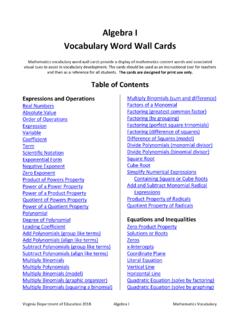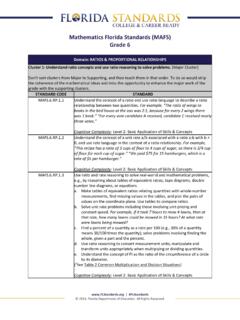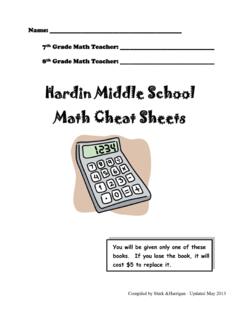Distributive Property Multiplication
Found 9 free book(s)END OF COURSE ALGEBRA I
www.doe.virginia.gov9 Which property justifies rewriting A Associative property of multiplication B Distributive property C Commutative property of multiplication D Associative property of addition 35 35 xx x − ( −) as? 8 Which is an equation for the line with and y-intercept of 3? F G H J yx=− 1 2 3 yx=+ 1 2 3 yx=+3 1 2 yx=+−3 1 2 slope = 1 2 VASpr08 EOC ...
Georgia Standards of Excellence Curriculum Frameworks ...
www.georgiastandards.orgStudents use the distributive property of multiplication as a strategy to multiply. 8. Look for and express regularity in repeated reasoning. Students use the distributive property of multiplication to solve for products they do not know. *Mathematical Practices 1 and 6 should be evident in EVERY lesson!
New York State Next Generation Mathematics Learning ...
www.nysed.govthen 4 × 6 = 24 is also known. (Commutative property of multiplication.) 3 × 5 × 2 can be found by 3 × 5 = 15, then 15 × 2 = 30, or by 5 × 2 = 10, then 3 × 10 = 30. (Associative property of multiplication.) Knowing that 8 × 5 = 40 and 8 × 2 = 16, one can find 8 × 7 as 8 × (5 + 2) = (8 × 5) + (8 × 2) = 40 + 16 = 56. (Distributive ...
Algebra I Vocabulary Word Wall Cards
www.doe.virginia.govMultiplication Property of Inequality Division Property of Inequality Linear Equation (standard form) ... Apply the distributive property. Example: (x + 3)(x + 2) x2 + 2x + 3x + = x2 + 5x + 6 x + 3 x + 2 1 = x = Key: x2 = Virginia Department of Education 2018 Algebra I Mathematics Vocabulary – Card 27
Mathematics Florida Standards (MAFS) Grade 6
www.fldoe.orgrelationship between multiplication and division to explain that (2/3) ÷ (3/4) = 8/9 because 3/4 of 8/9 is 2/3. (In general, (a/b) ÷ (c/d) = ad/bc.) How much ... Use the distributive property to express a sum of two whole numbers 1–100 with a common factor as a …
Linear Maps - University of California, Davis
www.math.ucdavis.edu3. Distributive property: (T1 +T2)S = T1S+T2S and T(S1 +S2) = TS1 +TS2 where S,S1,S2 ∈ L(U,V) and T,T1,T2 ∈ L(V,W). Note that the product of linear maps is not always commutative. For example if T ∈ L(P(F),P(F)) is differentiation Tp(z) = p′(z) and S ∈ L(P(F),P(F)) is multiplication by z2 given by Sp(z) = z2p(z), then
Algebraic Expressions packet
www.mayfieldschools.orgThe distributive property is multiplication over addition or subtraction. This means that in order to distribute, you must have a term (constant or variable) that is touching parentheses that contain more than one term. Those terms must
Hardin Middle School Math Cheat Sheets
www.jwilliamsmath.weebly.com1. Commutative Property Numbers can be added or multiplied in any order and the answer is still the same. Examples: Commutative Property of Addition: 3 + 2 = 2 + 3 a + b = b + a Commutative Property of Multiplication: 5(4) = 4(5) ab = ba 2. Associative Property When adding OR multiplying 3 or more numbers, they can be grouped in any way
Peano’s Axioms and Natural Numbers
www.math.wustl.edu= x(y+ z) + x (by de nition of multiplication) = (xy+ xz) + x (since z2S) = xy+ (xz+ x) (by associativity of addition) = xy+ x˙(z) (by de nition of multiplication) Thus by Induction, S= N and we have proved the lemma. Exercise 1. Prove the remaining properties stated above. Remember, you may use anything proved earlier for a proof, but no ...








